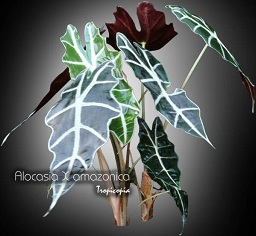Table of contents
Elephant ear

Latin Name: Alocasia X amazonica
Category: Other
Family: Araceae
Origin: Hybrid
Climate: Tropical humid
Growing Zones: 11
Care Instructions
The Elephant ear (Alocasia X amazonica) is a tropical humid plant that originates from Hybrid. This other plant belongs to the Araceae family and is well-suited for growing in USDA zones 11.
Complete Care Guide for Elephant Ear (Alocasia X Amazonica)
Watering Requirements
The Elephant Ear, or Alocasia X Amazonica, thrives in consistently moist soil, making proper watering essential for its health. It is crucial to keep the soil evenly moist but not soggy. Water the plant when the top inch of soil feels dry to the touch. During the growing season, typically spring and summer, you may need to water more frequently, possibly every 5-7 days, depending on the humidity and temperature of your environment. In the fall and winter, reduce watering as the plant enters a dormant phase; however, do not allow the soil to completely dry out. Overwatering can lead to root rot, so ensure that the pot has good drainage to prevent water from pooling at the bottom.
Light Conditions
Elephant Ear plants prefer bright, indirect light to thrive. Direct sunlight can scorch their large, lush leaves, leading to unsightly brown spots and damage. Ideally, place your Alocasia X Amazonica near a window that receives filtered light or in a well-lit room where it can enjoy bright, indirect sunlight for several hours a day. If you notice the leaves stretching towards the light, it may be a sign that the plant is not receiving enough light. Conversely, if the leaves are turning yellow, it could indicate too much direct sunlight. In low-light conditions, the plant may survive but will not grow as vigorously or produce as many leaves.
Soil Preferences
For optimal growth, the Elephant Ear requires a well-draining potting mix that retains moisture without becoming waterlogged. A blend of potting soil, peat moss, and perlite or orchid bark works well to provide the necessary aeration and drainage. Aim for a slightly acidic to neutral pH (around 6.0 to 7.0). Regular fertilization during the growing season can enhance growth; use a balanced, water-soluble fertilizer every 4-6 weeks. In the fall and winter, reduce fertilization as the plant’s growth slows down. Always ensure that the pot has drainage holes to prevent excess water from accumulating, which can lead to root rot.
Pests and Diseases
While the Elephant Ear is generally resilient, it can be susceptible to common pests such as spider mites, aphids, and mealybugs. Regularly inspect the undersides of the leaves and the stems for any signs of infestation. If you notice pests, treat them promptly with insecticidal soap or neem oil, ensuring to cover all affected areas. Additionally, watch for signs of fungal diseases, which can occur in overly humid conditions or if the leaves remain wet for too long. Yellowing leaves, wilting, or black spots can indicate disease. To prevent these issues, maintain good air circulation around the plant and avoid overhead watering.
Special Care Tips
To keep your Elephant Ear healthy and thriving, consider the following special care tips: First, maintain a humid environment, as these tropical plants prefer higher humidity levels. You can increase humidity by misting the leaves regularly, using a pebble tray filled with water, or placing a humidifier nearby. Additionally, rotate the plant occasionally to ensure even growth and prevent it from leaning towards the light source. If you notice any yellowing leaves, remove them promptly to encourage new growth and maintain the plant’s aesthetic appeal. Finally, be cautious when handling the plant, as the sap can be irritating to the skin; wearing gloves is advisable. With proper care, your Alocasia X Amazonica will reward you with stunning foliage and a vibrant presence in your home or garden.








